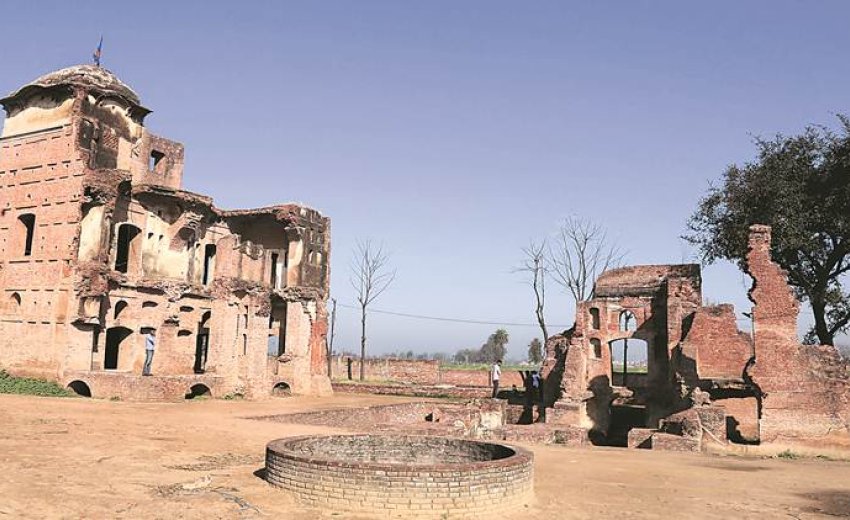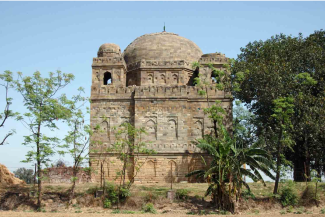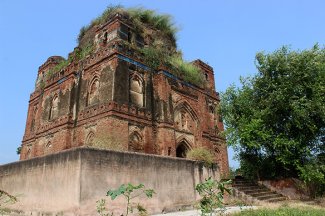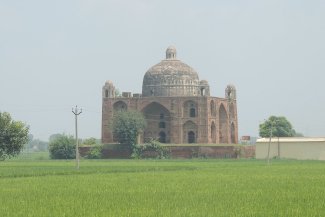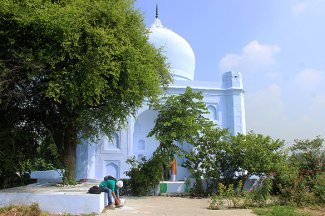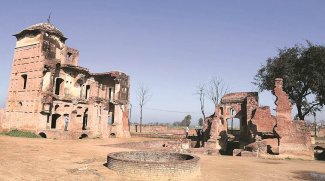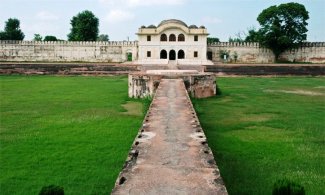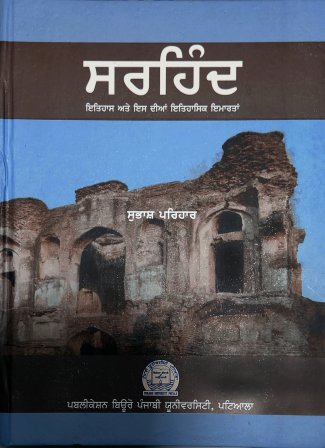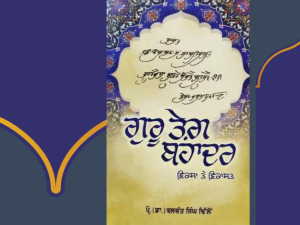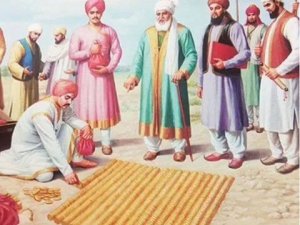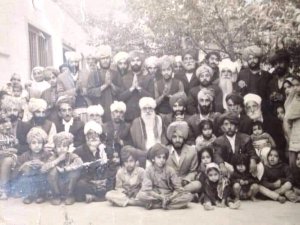INTRODUCTION
Banda Singh Bahadar has been accused of sacking the city of Sirhind in 1710 which according to many was only next to Lahore in Punjab in terms of grandeur. Mirza Mohd (1719) wrote that Banda Singh & his troops in their zeal to kill Muslims did not spare children and pregnant women.[1] Mohd Qasim (1723) in Ibratnama has stated Banda Singh in Sirhind destroyed prosperous places and broke and damaged mosques and tombs of ‘men of God’.[2] Subsequent Mughal chroniclers have added further exaggeration and interestingly the traditional Sikh writers who were biased against Banda Singh accepted it.[3] Even modern Sikh historians who are relatively more rational agree that Sirhind was destroyed by Banda Singh and his troops.[4] Then there is a section of Sikhs who justified ‘this destruction’ of Sirhind as revenge against Wazir Khan, the Faujdar of Sirhind who martyred the younger children of Guru Gobind Singh.
Based on this narrative, Banda Singh is a much-hated historical personality across Ravi in West Punjab. Successive modern historians and academics have accepted it as gospel truth without bothering to examine the current landscape of Sirhind. This write-up will look at the three-dozen existing Muslim structures in Sirhind which were all built before 1710. Dr Subhash Parihar has extensively written on Islamic buildings and their architecture in Punjab & Haryana. He is considered an authority on the subject and his academic works have been copiously used in this article.
The city of Sirhind hosts 12 historical mosques. The Mosque of Sadhana Qasai (Butcher) lies near the railway crossing of Fatehgarh Sahib. It was built during Khilji (1290-320) or early Tughlaq period (1320-1412). His one hymn is present in Guru Granth Sahib, in Raag Bilawal (p858). It is a state-protected monument under the Archaeology Department of Punjab.
There is a mosque on the road to Khanpur village. Dr Parihar writes that the building appears to be a mosque, but local people believe it was a treasury. It belongs to the same period as the Mosque of Sadhna Qasai.
The compound of the Rauza Sharif or Dargah of Shaikh Ahmad Sirhindi has three mosques. The first one was built in 1599-1600. Later a bigger mosque was built during the reign of Shah Jahan (1627-58). The second mosque is near the tomb of Khwajah Muhammad Masum and was constructed during the early years of the rule of Aurangzeb (1658-1707). The third and the smallest mosque was erected by Khwajah Zubair between 1703-09.
A mosque in a ruinous state is situated in the field west of the Rauza Sharif. It is considered to have been constructed during the monarchy of Shah Jahan. In the village, Talanian about 1.5 kilometers north of Rauza Sharif exists a Mosque which was completed in 1703. It is in good condition and was used as a Gurdwara.
About 1.5 kilometers west of Sirhind railway station at Shaikhupura a mosque exists and is contemporary to the period of the rule of Shah Jahan.
The White Mosque or Chitti Masjid near the village of Mahadian also belongs to the period of the rule of Shah Jahan. It was used as Gurdwara till the 1980s but now is locked. A new Gurdwara was built adjacent to the mosque. There are no Muslims in the village and the local Sikhs who look after the structure have whitewashed the building and it is now known as Chitti Masjid.
The Red Mosque or Lal Masjid is a functional mosque and was built by Shaikh Saifaldin (d. 1685). There are two mosques in the village of Mir Miran. The smaller mosque is used as a private residence and is in decent condition and built after 1710 but before 1763. The bigger mosque was built in the late 19th century has no dome and is also used as a private residence.[5]
All these structures are in decent condition and have been standing majestically for over 300 years.
HISTORICAL TOMBS
There are 23 historical tombs in Sirhind. Four of them belong to the Delhi Sultanate (1206-1526) period and the rest were built during the Mughal era.[6]It is not possible to write about all of them in a short article, but the important ones are being discussed.
The tomb of Princess Subhan, daughter of Sultan Bahlul Shah Lodi was completed in 1496. Amongst the locals, the tomb is known as Dera Mir Miran.[7] The structure is entirely made of stone probably procured by demolishing an ancient monument. It is in good condition and protected by the Department of Archaeology, Punjab.[8]
Another tomb of this period is situated in the village of Talanian but bears no inscription. It is popularly known as the tomb of Bibi Taj. Most probably a member of the ruling Lodi family lies interred in the tomb. Sadly, it is in a state of ruin and neglect. The local farmer in whose fields this tomb stands uses it for storage of farm produce.[9]
Near to the Aam Khas Bagh is the tomb of Hajji Muhammad built during the early 17th century.[10]
Same as Nakodar (district Jalandhar) there exist tombs of Ustad &Shagrid in Sirhind but they belong to different individuals. The ‘Ustad’ was probably Saiyad Khan Chaghatai, a governor of Punjab during the early years of Emperor Jahangir’s reign and he died around 1605- 06. Another view is that this tomb was raised as a memorial to the great architect and builder Ustad Syad Khan.[11]
Near the tomb of Ustad, there is another beautiful tomb of Khawaja Khan the ‘Shagird’ (Assistant) of Ustad Syad Khan. He too had attained great proficiency as a builder. The outer structure and design resembles that of Humayun’s tomb in Delhi.[12] Rauza Sharif is the dargah of Shaikh Ahmad Sirhindi who lived here from 1563 - 1624 and was the contemporary of Mughal Emperors, Akbar & Jahangir. The large complex also has mosques and several tombs built by Mughal Emperors. The Urs celebration (death anniversary) of the Shaikh is held here and is largely attended by Muslims from India and neighbouring countries.[13] Interestingly there is a letter from the Shaikh to Murtaza Khan, Governor of Punjab expressing his delight at the martyrdom of Guru Arjan Dev Ji in 1606. This letter in Persian came to the public forum only in the 20th century.[14]
Within the Rauza Sharif complex, there are several tombs. Towards the west of the tomb of Shaikh Ahmad Sirhindi lies the tomb of his son and successor Khwaja Mohammad Masum who died in 1668.[15] The tomb is also the remains of the seven of his descendants. To the north of this tomb is situated the tomb of his son, Khwaja Mohammad Siddiq. It was constructed in 1718. With the complex exists the tomb of Shaikh Mohammad Parsa, the grandson of Khwaja Mohammad Masum who died in 1732-33. To the south of the tomb of Khwaja Mohammad Masum, is the tomb of Khwaja Mohammad Zubair who died in 1740-41, and towards the west, lies the tomb of Mohammed Ismail.[16]
The tomb of Khwaja Mohammad Naqshband, another son of Khwaja Mohammad Masum exists half a kilometre north of Rauza Sharif. It was erected in 1702.
JAHAZ HAVELI
In 1871, Alexander Cunningham described the structure as the Haveli or dwelling house of Sahabat Beg, or Sandik Beg, the largest existing specimen of the ugly domestic architecture of the wealthy Mohammadans of the Mughal Empire. The Punjab State Gazetteers 1904 Phulkian States seems to be the first book to represent the structure as Jahaz (ship). Further, Sirhind Through the Ages published in 1972 seems to be the first work that refers to Diwan Todarmal as the owner of Jahazi Haveli without providing any reference.[17] After the partition of India, the structure fell into rapid disrepair and collapsed in many places.
AAM KHAS BAGH
Aam Khas Bagh, this Mughal Garden was founded between 1561- 81 during the reign of Akbar. Daulat Khana-i-Khas or royal residence was built during the reign of Mughal Emperor Shah Jahan (1628-58). The Royal couple used to stay here while going to and coming back from Lahore. The royal residence is in ruins although the garden is adequately kept. This was probably destroyed during the last attack by Sikhs on Sirhind in 1764. All other buildings of this garden namely Sard Khana, Hammam, tank, Naughara, Shish Mahal, etc. are intact.[18]
The bridge built during Shah Jahan’s period is in good condition and the Sirhind – Fatehgarh Sahib road passes over it. A Baoli (stepwell) probably built during this period lies buried under debris to the east of Aam Khas Bagh in the fields.[19]
EXTINCT STRUCTURES
Dr Parihar in the last chapter of his exceptional work, History & Architectural Remains of Sirhind mentions a tomb, tank with tower & bridge, Idgah, and Sirhind fort which existed during the British period and have gone extinct due to negligence and vandalism.
SIRHIND FORT – THE STORY OF THROWING OF THE BRICKS INTO THE RIVER.
The old Sirhind fort suffered damage during the successful capture of the city by Sikhs in 1764. The Misl Sardars (Sikh chiefs) were reluctant to take the detest city of Sirhind. It was given to Bhai Buda Singh, who soon after transferred the possession to Sardar Ala Singh, founder of the Patiala ruling family in August 1764 for an amount of Rs 25 lakhs.[20] The residents of Sirhind who had left the city were encouraged by Ala Singh to come and settle in his new capital, Patiala.[21]
Alexander Cunningham who visited Sirhind in 1863/64 writes that some Muslim families (from Sirhind) settled in the village Bassi (Pathania), four miles north of Sirhind and the village has transformed into a prosperous town.[22]
The old Sirhind Fort stood where now stands Gurdwara Fatehgarh Sahib. On 1st April 1822, Major Sir William Lloyd and Captain Alexander Gerard visited the old fort in Sirhind and noted that it was of moderate dimensions and built of bricks but in a ruinous state. In it were the ‘tombs of Guru Gobind (Singh)’s mother, and of his two children, who were cruelly put to death’.[23]
Later Maharaja Karam Singh of Patiala (1813-45) had Gurdwara Sahibs constructed in Sirhind in memory of the young martyrs and their grandmother.
Alexander Cunningham writes that every Sikh passing through Sirhind carries away a brick that he is supposed to throw into the river with the hope that in time this detested city will be removed from the face of the earth.[24] The British hastened the demise of old Sirhind (fort) by liberally using the bricks of Sirhind fort as ballast material while laying down the railway lines.
PRACHIN PANTH PARKASH
Bhai Rattan Singh Bhangu completed his Sri Gur Panth Prakash popularly known as PrachinPanth Prakash in 1841. He states that Banda Singh did not destroy Sirhind and expresses his unhappiness. He writes “Banda entered into the precincts of the city of Sirhind and took possession of the whole treasure of Wazir Khan. He occupied, but he did not ransack the city of Sirhind, for which lapse he had to repent later on.”[25]
It further states that Banda (Singh) stopped the plunder and safeguarded the city. Bhangu seems aggrieved that the city was not destroyed contrary to the advice![26]
PREVIOUS WRITERS ON BANDA SINGH & SIRHIND
John Gordon in 1904 wrote that when implored by Sikhs to destroy Sirhind, Guru Gobind Singh told them that the death of his sons would not be avenged by the destruction of the town, which had done no harm, but that for the future every true Sikh who passed that way should pull down two bricks and throw them into the river in detestation of the crime committed on innocent children.[27] Ganda Singh in 1935 wrote that the allegation about the desecration of mosques by Banda Singh was unfounded. He quotes Gokul Chang Narang’s Transformation of the Sikhism written in 1912 where it is stated that the mausoleum of Ahmad Shah (Shaikh Ahmad Mujaddid Alf Sani), the most magnificent of all such buildings, still stands as it did before the battle.[28]
CONTEMPORARY REPORTS
The letter written by Chabeel Das to his overlord, Maharaja Sawai Jai Singh of Jaipur in 1710 states that Sikhs have established their authority in Sirhind and have decreed that no one should kill any bird or any animal.[29]
It seems very strange for someone who is accused of the destruction of the city and mass murders, Banda Singh proclaimed that no one should be killed, not even a bird or animal.
Akhbar-i-Darbar-i-Mualla were Mughal Court bulletins in the Persian language which included provincial newsletters and reports of generals and governors, orders, activities, and observations of the Emperors, appointments, promotions, transfers, dismissals, and references to other matters of State.
Akhbar-i-Darbar-i-Mualla dated 23rd June 1710, five weeks after the victory and occupation of Sirhind, reports that Banda Singh told Jan Muhammad, the Zamindar of Gulab Nagar (Buriya) “I have forgiven your crime and made you the Zamindar of the whole paraganah. You should proceed with your men and bring in Sardar Khan of Chundla. Then you will accompany me for the chastisement of Jalal Khan Afghan.”[30]
Jalal Khan Afghan was harassing Sikhs and Hindus in his region. Banda Singh went there with his Muslim supporters to chastise him. Banda Singh was not against Muslims but against oppression. People from poor segments of society from all communities joined him. Most of them were farmers but there were others as well. Akhbar-i-Darbar-i-Mualla dated 28th April 1711 notes “The rebel Nanak-worshipper (Banda Singh) was encamped at Kalanaur upto April 26. He had given a word and expressed his resolve not to harass the Muslims. Therefore, all those Muslims who joined him (Banda Singh) were given daily allowance and wages and were properly looked after. He had permitted them to read khutba and offer prayers. Thus, 5000 Muslims had joined the service of the rebel Sikh leader. With freedom of azan (call for prayer) and the namaz (daily prayer), these Muslims were feeling comfortable in the army of the rebels (Sikhs).”[31]
CONCLUSION
Some medieval chroniclers have stated Sirhind had 360 mosques, gardens, tombs, caravanserais and wells. This is figure of speech or poetic exaggeration and not meant to be taken literally. Sirhind may have been beautiful during the Shah Jahan & Aurangzeb’s era but the only garden in the city which finds mention in Farsi records is the Naulakha Bagh which is identified as Aam Khas Bagh. Similarly, only two caravanserais outside Sirhind Fort are mentioned in the historical documents.[32]
Amritsar was the city of gardens under Maharaja Ranjit Singh. The Maharaja laid down at least a dozen gardens in Amritsar. Now there are hardly 1-2 gardens in the whole city. Post-partition the haphazard construction and converting the cities into concrete jungle has meant that they have lost almost all their gardens. One cannot blame Banda Singh or Misl Sardars for the loss of gardens, if any in Sirhind.
Sirhind lost its royal patronage and became one of the towns of Punjab under the Sikhs. It is wrong to say that it was destroyed by Banda Singh Bahadar or later by Misl Sardars. There are over 3 dozen preserved Islamic structures mostly built before 1710. There is a huge difference between destruction and neglect. Punjab is not very good at preserving its heritage. Even structures like Baradari in Dinanagar (district Gurdaspur) built by Maharaja Ranjit Singh who was state icon are facing neglect.
Mughals recaptured Sirhind by the end of 1710, within 6 months of losing it however it was again won by Banda Singh, but Mughals again captured the city, but Banda Singh and his troops held the swap in the countryside till 1716. Mughals held Sirhind till 1752 when it passed on to Ahmad Shah Abdali who eventually lost it to Misl Sardars in 1764. There is no Mughal account that they had to rebuild the city after recapturing it from Banda Singh. The contemporary Mughal newsletters make no mention of any destruction of Sirhind or killing of inhabitants by Sikhs or anyone.
Many of us in East Punjab have metaphorical heard the idiom that Banda Singh Bahadar Ne Sirhind de Itt naal Itt Kharkati. This idiom means the annihilation of Mughal power in Sirhind and does not mean the destruction of the city and the killing of its population. Mughal history is well documented and people who subscribe to the view that Banda Singh (or Misl Sardars) destroyed and sacked Sirhind (especially Muslim structures) should quote from Mughal records, the names of Mughal or Muslim historical structures that were completely razed to the ground by Sikhs. If they are unable to name them then it is time to revisit the so-called destruction of Sirhind by Banda Singh Bahadar and set the record straight. The documentary evidence reproduced above in this article and the exact state of existing Islamic structures in Sirhind at present (2024) bears testimony to the fact that Banda Bahadur has been more sinner against than sinning. .
~~~
REFERENCES
1. J. S. Grewal & Irfan Habib (2001) Sikh History from Persian Sources. New Delhi: Tulika. p134
2. Ibid. p118
3. Mohan Singh Hira (2022) Guru Da Banda - Banda Singh
40 ABSTRACTS OF SIKH STUDIES: JULY-SEPT 2024/ 556 NS
Bahadar (Punjabi). Chandigarh: Unistar p328-378
4. Khushwant Singh in A History of the Sikhs Vol1 1469-1839, first published in 1963 wrote ‘Sirhind was destroyed in detail; only a few mausolea were spared’.
5. Subhash Parihar (2004) Historical Mosques of Sirhind. Islamic Studies. Vol 43. No. 3 p481-510
6. Subhash Parihar (2006) History & Architectural Remains of Sirhind. Delhi: Aryan Books International.p99
7. Subhash Parihar (1999) Arabic and Persian Inscriptions from Sirhind. Islamic Studies. Vol 38. No.2 pp. 255-74
8. Subhash Parihar (2006) op. cit. p103
9. Ibid. p108
10. Ibid. p111
11. Ibid. p113
12. Ibid. p120-21
13. Ibid. p116
14. Ganda Singh (1981) The Martyrdom of Guru Arjan. The Sikh Review. June.p11-26
15. Subhash Parihar (2006) op. cit. p123
16. Ibid. p130-36
17. Inderjeet Singh (2023) Jahazi Haveli of Sirhind in History. Abstracts of Sikh Studies. Vol XXVI. Issue 3. p35-41
18. Subhash Parihar (2006) op. cit. p189-91
19. Subhash Parihar (2006) op. cit. p209-10
20. Ganda Singh (1990 tr.) Sardar Jassa Singh Ahluwalia. Patiala: Punjabi University.p133
21. Ibid. p134
22. Alexander Cunningham (1871) Archaeological Survey of India Four Reports made during the years 1862-63-64-65 Vol II. Simla: Government Central Press p209
23. William Lloyd & Alexander Gerard (1840) Narrative of a Journey from Caunpoor to the Boorendo Pass in the Himalaya Mountains via Gwalior, Agra, Delhi &Sirhind. Vol 1 London: J. Madden & Co. p74-75
24. Alexander Cunningham (1871) op. cit. p208-09
DEBUNKING THE MYTH OF DESTRUCTION OF SIRHIND BY BANDA SINGH BAHADAR 41
25. Kulwant Singh (tr.2006) Sri Gur Panth Prakash (Rattan Singh Bhangoo) Vol 1 (Episodes 1 to 81). Chandigarh: Institute of Sikh Studies. P245
26. Balwant Singh Dhillon (ed.2004) Sri Gur Panth Prakash Kirt S. Rattan Singh Bhangu (Punjabi). Amritsar: Singh Brothers. p95
27. John Gordon (1904) The Sikhs. London: William Blackwood & Sons p47
28. Ganda Singh (1935) Life of Banda Singh Bahadur based on Contemporary and Original Records. Amritsar: Khalsa College p70-71
29. Balwant Singh Dhillon (2022) Banda Singh Bahadur Farsi Sarot (Punjabi). Amritsar: Singh Brothers.p55
30. Bhagat Singh (1984) Akhbar-i-Darbar-i-Mualla. The Panjab Past and Present. Vol XVIII. No.2. pp27-28
31. Ibid.p63
32. Subhash Parihar (2006) op. cit. p222
